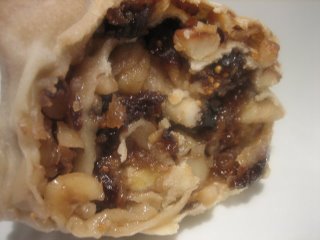
Milan is a second home to me. Although I am a Southerner, my mom is from Bergamo and I spent 7 years of my life in Milan. I love that city, with its melancholy warm embrace.
And I love the food...very rich, so different than the southern Italian style, very French to me.
One of the books I love most is La Cucina Milanese written by Marco Guarnaschelli Gotti. He is a jornaulist from Milan. The book is beautifully written, full of hystoric references and family anecdotes. This book never failed me.
Osso buco, plural ossi buchi, is a wintery dish. It is better to use the ossi buchi coming from the posteriore leg of the veal, they are more tender. The osso buco should be pretty thick, about 4 cm height. Ideally it should be cut at the middle of the muscle where there is a good balance between meat and connective tissue, important for the glaze effect in the sauce. It's reccomanded to cut in a couple of spots on the external connective tissue of the osso buco beetween the musclar fascia, without unbundling it.
There are many recipe calling for a battuto or onion, carrots and celery. Marco Guarnaschelli suggests the easiest of the recipes...and I just love it.
In a brasiere sweat 60 g of butter and 2 small spring onions, only white part, finely minced. After 15 minutes put them aside. Brown the ossi buchi, slightly flour them and shake off the excess, in the same brasiere, taking care to brown nicely also the sides, return the onion in the pot, deglaze with dry white wine, lower the heat and let evaporate slowly. Add salt and a little bit of good meat stock, bring to a simmer, cover and bake at 140 C until the meat is tender and the sauce glossy. Turn every once in a while and check for liquid level. It will take about 2 hours. Toward the end of cooking mince finely a glove of garlic, add some chopped parsley and lemon zest. This is the gremolata to add to the sauce at the end, whisk and serve usually with risotto or a potato pure'. Which risotto? Giallo (yellow, that's how milanesi call the risotto with saffron, of course they don't call it alla milanese!), or in bianco, alla parmigiana, with no saffron. I like more the parmigiana version for this dish but my husband like more the yellow version.
For the risotto giallo
It nice to use a "russe" kind of pot, with an handle. The best would be a risottiera in copper with tin. Mince half of a small white or golden onion, not the red one and let it sweat very gently with 50 g of butter and 15 g of marrow. This all process should take about half an hour and its very imporant as liason. If it gets color just add a drop of water, at the end it should look like in ivory cream. Add the rice: two handful a person plus one for the pot, never cook anyway more than 800 g at a time. Which rice? The author says that it will dipend from the quality of the rice. And I totally agree with him. True good quality carnaroli is hard to find, and honesty, restaurants like it because it's easier to handle: doesn't overcook as much as other rices. I find it very often not creamy enough for my taste. This time for example I used a very good baldo. Let "toast" the rice. The term toasting is a little mischieving, the rice should not get any colour and stirred with the wooden spoon at all times, but especially at this moment. Meanwhile warm up some good stock (about 1 litre or 1 and half liters to be safe, for a four servings). Start adding the stock, one laddle, then higher the heat until bubbles, stir and keep adding stock as it evaporates. It is important to stir very often, in this way the rice will release the starch. It would take about 18 to 20 minutes to cook, depending from the rice. In between stirring grate some cheese. Grana is more a lombardo cheese but parmigiano is also ok. For four people add 50 grams of grated cheese to the bottom of the serving dish, plus some dots of butter. On grating cheese. I always see foreigners using graters with big holes and I wonder why. Its too tiresome to grate properly some cheese? I love the snow consistency of the fine grating and that's the way should be in this dish. Coarse grating I guess is more used in sicilian style pastas with hard ricotta.
Going back to the recipe. Toward the end of cooking, when 4 minutes are missing, add 30 grams of grated grana to the pot. Stirring at this point is important. With the cheese in it, it's more prone to stick. Dissolve some saffron in a little stock and add it to the rice two minutes from end of cooking. Taste for salt and check liquid level. Pour on the serving dish in which the cheese and the butter are resting. Stir briefly the rice in the serving dish, this will create the "wave" typical from risotto alla milanese.
The author doesn't suggest to serve it in the cooking pot, or to let it rest in it, to avoid the risk of overcooking the rice.
This time my risotto came very good, I should have kept it a little runny.
I din't serve the ossi buchi directly on top of the rice, I like to keep my food separate. A little curiosity: the spoon to scoop out the marrow from osso buco is called esattore (in italian is a tax collector :-))









